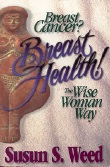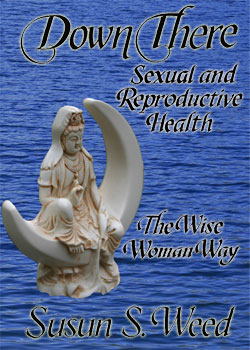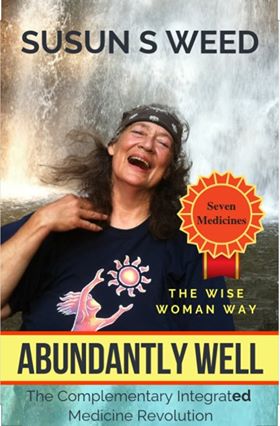
INDEX | HEALING WISE | Q & A with SUSUN | GREEN BLESSINGS
THE LIBRARY | PEOPLE MAKING CHANGE | GODDESS ART GALLERY
Healing Wise ...
with Susun Weed
Echinacea
Almost everyone has heard of echinacea, the herbal "antibiotic," and a great many have taken it in one form or another. But when I first began to use it, thirty years ago, after reading about it in an old eclectic herbal, very few people had ever tried it. Back then, most herbalists relied on golden seal to counter infections.
But golden seal (Hydrastis canadensis) is extremely bitter, and golden seal is rare—and getting rarer. It did not appeal to me then; and it does not appeal to me now. In nearly forty years of using herbs, I have used golden seal only once—on flayed skin. I would never use it internally. If forced to choose between an antibiotic and golden seal, I would choose the former. Golden seal can do more harm to gut flora and the liver than most antibiotics.
But I don't want to take antibiotic drugs now, and I didn't then either. So I searched for anti-infective herbs. I found yarrow, now my favorite antiseptic. (See my previous column, and my next book, for more on this great herb.) I found garlic, which I use lavishly in cooking, believing it to be better at prevention than treatment. I found cayenne, which nearly killed me and which I loathe to this day. And finally I found echinacea, the purple cone flower.
Looking like a black-eyed Susan with purple-pink petals, purple cone flower's home territory was originally the Great Plains from Kansas to Montana and south into Oklahoma. But echinacea is an herb that loves people. So now it grows from coast to coast, and in every state in between, wherever gardeners who love beautiful and care-free plants live.
The easiest to grow is Echinacea purpurea. More difficult to cultivate, but the most medicinal, is Echinacea augustifolia (or angustifolia). But the roots of all the echinaceas, including the rare E. pallida and the fancy new cultivars, contain anti-infective alkaloids which are easily extracted into water and/or alcohol.
Don't expect instant gratification from growing echinacea. Like most perennials, echinacea roots don't really start concentrating alkaloids until after they have been growing for at least three years. While waiting for those roots to mature, some herbalists tincture the leaves and flowers. They do contain some effective alkaloids, but they are so inferior in action to yarrow or usnea that I never bother. A tincture of echinacea seeds is a little better, in my experience. But for maximum effect, I wait for the roots, or I make a tincture of dried roots.
Drying the roots of E. purpurea seems to destroy their effectiveness, so I use the dried roots of E. augustifolia when I make my tincture. I fill a quart jar about one-third full of dried, cut echinacea roots, then add enough 100 proof vodka to fill the jar completely. I label it with the date and ingredients and screw on a tight lid. I shake the jar daily for a few days, and then let it rest in a cool, dark place for as long as possible.
Unlike most tinctures, which are ready to use in six weeks, tincture of echinacea made from dried augustifolia roots gets stronger and stronger during its first year in the vodka.It gains no more after that year, but neither does it loose strength. So I buy a pound of dried E. augustifolia and make three or four quarts of tincture instead of just one.
(To tincture fresh purpurea roots: dig them after frost; wash and chop them; fill a jar to the top with the fresh roots, then fill the jar to the top with 100 proof vodka. Label. No need to shake. Ready in six weeks, but it does mature nicely.)
My dear friend and guardian angel Keyawis Kaplan calls echinacea "the big E for emergency." And so it is. Echinacea builds white blood cells rapidly, effectively countering a wide range of bacterial infections such as mastitis, UTIs, staph, strep, blood poisoning, sinusitis, bronchitis, tooth and gum infections, chronic and acute sore throat, and surgical as well as accidental wounds.
Combined with burdock, I have known echinacea to clear genital herpes, a viral infection. In general, however, echinacea is not much help against viral infections.
This brings up the question of echinacea's usefulness in dealing with the viruses that cause colds and the flu. In my experience, since both colds and the flu are often accompanied—or immediately followed by—bacterial infections in the sinuses, throat, and lungs, echinacea can be a helpful ally to counter them. I do use it at the very first sign of a cold or the flu, along with immune-boosting herbs such as Astragalus cooked up in a soup.
When I use echinacea tincture, I use a lavish dose: 1 drop for every 2 pounds of body weight. A dropperful (which looks like half a dropperful) is about 25 drops of tincture. So I use a dropperful for children 25-50 pounds. Two dropperfuls for those weighing 50-100 pounds. Three dropperfuls for up to 150 pounds. Four for up to 200, and so on.
I take the full dose as often as every 1-2 hours in a crisis, or every 3-4 hours if I catch the infection at an early stage. And I expect to see relief within the first 24 hours. As I do, I space the doses further and further apart until all symptoms are gone. I don't count the days or the weeks that I use echinacea. If the infection warrants it—as when my goose "Sweetheart" was attacked by a toothed being (dog? coyote? fox?) and had his armpit ripped out—I will use large doses for months on end until all signs of infection (redness, pain and tenderness, heat or fever) are gone.
As is always the case, I never use echinacea in capsules. In my experience, dried herbs in capsules are the least effective physically, the most expensive financially, and the most dangerous way to take herbs: plenty of reasons to avoid them.
If you have concerns about alcohol, put your dose into hot liquid to dispel the alcohol, or brew the dried roots of E. augustifolia into an infusion by placing one ounce by weight of the root in a pint jar, filling it to the top with boiling water, capping tightly, and brewing for eight or more hours. I figure that one ounce of this infusion is equal in action to a dropperful of tincture. (You'll notice this is a very expensive way to use echinacea.)
I have so much to say about echinacea that I could go on and on. I've hardly started and already this column is at the end.
Green Blessings

|
Susun Weed’s books: |

|
Wise Woman Herbal for the Childbearing Year
Author: Susun S. Weed.
Simple, safe remedies for pregnancy, childbirth, lactation, and newborns. Includes herbs for fertility and birth control. Foreword by Jeannine Parvati Baker. 196 pages, index, illustrations.
Retails for $14.95
Order at: www.wisewomanbookshop.com
|

|
Healing Wise
Author: Susun S. Weed.
Superb herbal in the feminine-intuitive mode. Complete instructions for using common plants for food, beauty, medicine, and longevity. Introduction by Jean Houston. 312 pages, index, illustrations.
Retails for $21.95
Order at: www.wisewomanbookshop.com |

|
NEW Menopausal Years the Wise Woman Way
Author: Susun S. Weed.
The best book on menopause is now better. Completely revised with 100 new pages. All the remedies women know and trust plus hundreds of new ones. New sections on thyroid health, fibromyalgia, hairy problems, male menopause, and herbs for women taking hormones. Recommended by Susan Love MD and Christiane Northrup MD. Introduction by Juliette de Bairacli Levy. 304 pages, index, illustrations.
Retails for $22.95
Order at: www.wisewomanbookshop.com
For excerpts visit: www.menopause-metamorphosis.com
|

|
Breast Cancer? Breast Health!
Author: Susun S. Weed.
Foods, exercises, and attitudes to keep your breasts healthy. Supportive complimentary medicines to ease side-effects of surgery, radiation, chemotherapy, or tamoxifen. Foreword by Christiane Northrup, M.D. 380 pages, index, illustrations.
Retails for $21.95
Order at: www.wisewomanbookshop.com
|

|
Down There: Sexual and Reproductive Health the Wise Woman Way
Publication date: June 21, 2011
Author: Susun S. Weed
Simple, successful, strategies cover the entire range of options -- from mainstream to radical -- to help you choose the best, and the safest, ways to optimize sexual and reproductive health.
Foreword: Aviva Romm, MD, midwife, 484 pages, Index, illustrations.
Retails for $29.95
Order at: www.wisewomanbookshop.com
|

|
Abundantly Well - Seven Medicines
The Complementary Integrated Medical
Revolution
Publication date: December 2019
Author: Susun S. Weed
Seven Medicines build foundational health and guide you to the best health care when problems arise.
Includes case studies, recipes, exentsive references and resources. Introduction by Patch Adams illustrated by Durga Yael Bernhard 352 pages, index, illustrations
Retails for $24.95
Order at: www.wisewomanbookshop.com
|
|
|
|
Wise Woman Herbal Ezine is sponsored by
www.susunweed.com and www.wisewomanbookshop.com
HEALING WISE | Q & A with SUSUN | GREEN BLESSINGS
THE LIBRARY | PEOPLE MAKING CHANGE | GODDESS ART GALLERY
©Susun
Weed -Wise Woman Center
~ Disclaimer & Privacy Policy ~
|








